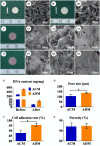Biological Evaluation of Acellular Cartilaginous and Dermal Matrixes as Tissue Engineering Scaffolds for Cartilage Regeneration
- PMID: 33505975
- PMCID: PMC7829663
- DOI: 10.3389/fcell.2020.624337
Biological Evaluation of Acellular Cartilaginous and Dermal Matrixes as Tissue Engineering Scaffolds for Cartilage Regeneration
Abstract
An acellular matrix (AM) as a kind of natural biomaterial is gaining increasing attention in tissue engineering applications. An acellular cartilaginous matrix (ACM) and acellular dermal matrix (ADM) are two kinds of the most widely used AMs in cartilage tissue engineering. However, there is still debate over which of these AMs achieves optimal cartilage regeneration, especially in immunocompetent large animals. In the current study, we fabricated porous ADM and ACM scaffolds by a freeze-drying method and confirmed that ADM had a larger pore size than ACM. By recolonization with goat auricular chondrocytes and in vitro culture, ADM scaffolds exhibited a higher cell adhesion rate, more homogeneous chondrocyte distribution, and neocartilage formation compared with ACM. Additionally, quantitative polymerase chain reaction (qPCR) indicated that expression of cartilage-related genes, including ACAN, COLIIA1, and SOX9, was significantly higher in the ADM group than the ACM group. Furthermore, after subcutaneous implantation in a goat, histological evaluation showed that ADM achieved more stable and matured cartilage compared with ACM, which was confirmed by quantitative data including the wet weight, volume, and contents of DNA, GAG, total collagen, and collagen II. Additionally, immunological assessment suggested that ADM evoked a low immune response compared with ACM as evidenced by qPCR and immunohistochemical analyses of CD3 and CD68, and TUNEL. Collectively, our results indicate that ADM is a more suitable AM for cartilage regeneration, which can be used for cartilage regeneration in immunocompetent large animals.
Keywords: acellular cartilaginous matrix; acellular dermal matrix; cartilage regeneration; immune responses; tissue engineering.
Copyright © 2021 Wang, Xu, Zhou, Liu and Cao.
Conflict of interest statement
The authors declare that the research was conducted in the absence of any commercial or financial relationships that could be construed as a potential conflict of interest.
Figures







Similar articles
-
[Repair of thyroid cartilage defects with chondrocyte-allogenous acellular cartilaginous matrix composite in rabbits].Zhongguo Xiu Fu Chong Jian Wai Ke Za Zhi. 2005 Jun;19(6):478-80. Zhongguo Xiu Fu Chong Jian Wai Ke Za Zhi. 2005. PMID: 16038468 Chinese.
-
Naringin in the repair of knee cartilage injury via the TGF-β/ALK5/Smad2/3 signal transduction pathway combined with an acellular dermal matrix.J Orthop Translat. 2021 Aug 6;32:1-11. doi: 10.1016/j.jot.2021.06.004. eCollection 2022 Jan. J Orthop Translat. 2021. PMID: 35591936 Free PMC article.
-
[PREPARATION OF ACELLULAR DERMAL MATRIX AS A KIND OF SCAFFOLD FOR CARTILAGE TISSUE ENGINEERING AND ITS BIOCOMPATIBILITY].Zhongguo Xiu Fu Chong Jian Wai Ke Za Zhi. 2014 Jun;28(6):768-72. Zhongguo Xiu Fu Chong Jian Wai Ke Za Zhi. 2014. PMID: 26455234 Chinese.
-
[Application of acellular matrix in cartilage tissue engineering].Zhongguo Xiu Fu Chong Jian Wai Ke Za Zhi. 2009 Apr;23(4):501-4. Zhongguo Xiu Fu Chong Jian Wai Ke Za Zhi. 2009. PMID: 19431995 Review. Chinese.
-
Acellular dermal matrix in urethral reconstruction.Front Pediatr. 2024 Feb 9;12:1342906. doi: 10.3389/fped.2024.1342906. eCollection 2024. Front Pediatr. 2024. PMID: 38405593 Free PMC article. Review.
Cited by
-
Enhancing Cartilage Repair: Surgical Approaches, Orthobiologics, and the Promise of Exosomes.Life (Basel). 2024 Sep 11;14(9):1149. doi: 10.3390/life14091149. Life (Basel). 2024. PMID: 39337932 Free PMC article. Review.
-
Construction of three-dimensional, homogeneous regenerative cartilage tissue based on the ECG-DBM complex.Front Bioeng Biotechnol. 2023 Sep 25;11:1252790. doi: 10.3389/fbioe.2023.1252790. eCollection 2023. Front Bioeng Biotechnol. 2023. PMID: 37818235 Free PMC article.
-
Chondrogenic medium in combination with a c-Jun N-terminal kinase inhibitor mediates engineered cartilage regeneration by regulating matrix metabolism and cell proliferation.Regen Biomater. 2023 Sep 7;10:rbad079. doi: 10.1093/rb/rbad079. eCollection 2023. Regen Biomater. 2023. PMID: 38020237 Free PMC article.
-
Using a Xenogeneic Acellular Dermal Matrix Membrane to Enhance the Reparability of Bone Marrow Mesenchymal Stem Cells for Cartilage Injury.Bioengineering (Basel). 2023 Aug 2;10(8):916. doi: 10.3390/bioengineering10080916. Bioengineering (Basel). 2023. PMID: 37627801 Free PMC article.
-
The Immunosuppressive Niche Established with a Curcumin-Loaded Electrospun Nanofibrous Membrane Promotes Cartilage Regeneration in Immunocompetent Animals.Membranes (Basel). 2023 Mar 14;13(3):335. doi: 10.3390/membranes13030335. Membranes (Basel). 2023. PMID: 36984722 Free PMC article.
References
-
- Asawa Y., Sakamoto T., Komura M., Watanabe M., Nishizawa S., Takazawa Y., et al. (2012). Early stage foreign body reaction against biodegradable polymer scaffolds affects tissue regeneration during the autologous transplantation of tissue-engineered cartilage in the canine model. Cell Transplant. 21 1431–1442. 10.3727/096368912x640574 - DOI - PubMed
-
- Chen W., Xu Y., Li Y. Q., Jia L. T., Mo X. M., Jiang G. N., et al. (2020b). 3D printing electrospinning fiber-reinforced decellularized extracellular matrix for cartilage regeneration. Chem. Eng. J. 382:122986 10.1016/j.cej.2019.122986 - DOI
LinkOut - more resources
Full Text Sources
Other Literature Sources
Research Materials

